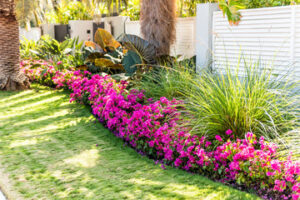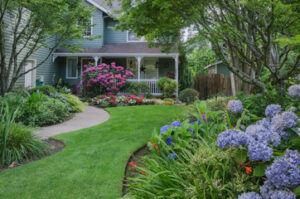Stafford VA Landscaping improves property value and boosts curb appeal. It also improves the environment by absorbing carbon dioxide and releasing oxygen. It also provides habitat for wildlife and reduces pest populations by utilizing natural repellents.

Take your time when planning a new landscape and visit botanical gardens, arboretums, local garden centers and estate gardens for ideas. Pay special attention to focal points and how these areas are maintained.
The color of a landscape is an important part of the overall design. The right colors can enhance a property’s curb appeal and complement the architectural style of the house or commercial building. The color of a plant can also affect the mood of the occupants and encourage them to spend more time outdoors.
A well-designed logo can make your landscaping business stand out from competitors and help potential customers remember your brand. A strong brand identity can lead to customer loyalty, which will increase your sales and allow you to charge premium prices for your services. Create a brand style guide that lists all the details of your branding, including logos, colors, fonts, and language. Use this guide to ensure consistency across all marketing channels. Paint your landscaping tools and equipment in your company’s colors to reinforce the brand at job sites.
A landscape is more than just a beautiful addition to a home or business; it can improve health and well-being by encouraging outdoor activity and social interaction. A pristine yard can also boost a property’s value, making it more attractive to potential buyers. Landscapes can be designed in a variety of styles to reflect individual preferences. Some styles include geometric shapes and clean lines while others are more organic and natural.
Texture
While color is often regarded as the most important element of landscape design, it’s crucial to also consider texture when creating your garden. The texture of plant foliage and bark is what defines the overall visual experience and adds contrast to the landscape, capturing the eye’s attention and stimulating the senses.
Texture consists of the surface roughness and feel of a plant, whether it’s coarse or fine, thick or thin, soft or hard. This characteristic describes how the plant feels when touched and can be found in the foliage, flower, and bark of plants as well as in the hardscape elements of your garden such as rocks, bricks, and wood.
The perception of a plant’s texture can change depending on the viewer’s distance from the planting as well as the surrounding environment, so it’s important to understand how different textures will work in your landscape. For example, close up, needle-leaved trees can look fine textured but when seen from a distance they can appear coarse if combined with a large number of tightly-packed plants that produce a dense effect.
Using a variety of plant textures throughout your garden creates interest and contrast, and can even help to manipulate the perceived scale and distance of a space. When placed on the perimeter of a garden, fine textures recede, making the garden feel larger while coarse textures draw in the space, bringing elements forward and creating an intimate feeling.
Planting with texture in mind will also ensure that your landscape looks fresh and interesting year-round. As leaves mature and fronds of plants fall, replacing them with newer specimens that offer a similar textural contrast will keep your garden looking fresh and inviting.
Whether it’s bold, dramatic, or subtle and harmonious, the use of texture can help to shape your landscape and create a truly captivating outdoor experience. The key is to make sure that the textures you choose are complementary and not jarring when juxtaposed, so that each element contributes to the whole rather than dominating it. And remember that texture isn’t just about foliage and flowers, incorporating tree bark and other natural hardscape features can add interesting moments of contrast.
Lines
Lines are one of the most important elements to consider when creating a landscape. They can be straight, curved, diagonal, or wavy and serve to frame views, add structure to the landscape, create paths, and divide areas. They can also be used to add movement, depth, and a sense of proportion. Proper use of lines can have a dramatic effect on the landscape, transforming it from mundane to spectacular.
Lines can be created by both natural and man-made means. Natural lines include contours of hills and valleys, curves in the path of a stream or river, and winding roads and sidewalks. Man-made lines include fences, pathways, driveways, and garden walls. Both natural and man-made lines can be effective in the landscape, but it is important to remember that they must be in balance with the other elements.
While straight lines evoke order and formality, curved lines create an inviting ambiance and give the garden a more natural feel. Curved lines also allow the eye to meander and explore different areas of the garden, adding a sense of mystery and intrigue. If straight lines are used, they should be limited to short paths that lead to special attractions and pause points within the larger space.
Horizontal and lateral lines pull the eye across the ground plane, broadening the view and tying spaces together. Short garden walls, edging with plants or stone and hedges are examples of horizontal lines that work to define and tie the space together.
Vertical lines evoke a sense of upward movement and make the space feel larger and full of energy. Tall trees and structures like arbors, trellis, and pergolas are examples of vertical lines that can be used in the landscape.
When combined with color and texture, the use of lines can create rhythm in the landscape and make it more aesthetically pleasing. This is accomplished by repetition, which can be achieved by using different forms of lines in a design, or by repeating the same shape or color throughout the landscape.
The most obvious use of lines in the landscape is the property line fence, which clearly defines where your property ends and where your neighbor’s begins. If you’re considering fencing, it’s a good idea to consult with a surveyor or other professionals to ensure you’ve got the right information before making a decision.
Space
Whether it’s an eye-catching fountain surrounded by serene gardens or a winding pathway leading to your backyard oasis, focal points draw the viewer’s attention and create a harmonious space. Focal points like these can also express your unique sense of style and serve as a way to tie together different elements in the landscape.
While the trend is towards a more natural-feeling landscape, it doesn’t mean that your house should be left behind. By using a combination of hardscape and softscape (plants), we can balance dwelling and nature, allowing both to take center stage. Depending on your needs and wants, a balanced landscape may include separate zones like dining areas, lounging spaces with seating or outdoor kitchens, play and garden areas for the kids, and green and shaded spaces for resting and meditation.
Besides enhancing curb appeal, a well-designed landscape can increase property value. A landscaper can help you maximize square footage, creating new spaces for entertaining or relaxing, while integrating them into the overall layout.
Landscaping also includes the installation of structures and features, such as pathways, decks, patios, and lighting, to transform an outdoor area according to a design plan. This can include anything from grading and excavation to installing water features and retaining walls. It also includes implementing sustainable practices, like incorporating native plants that thrive in the local climate and soil conditions, as well as designing irrigation systems that conserve water use.
Incorporating these elements into a design plan ensures that the resulting space is functional, meets maintenance requirements, and complements your home’s architectural style. It also helps to determine a budget and establish project goals before breaking ground, which saves you time and money in the long run by preventing costly mistakes and revisions.
Whether you are building your dream outdoor space or simply updating it, a landscape design allows you to see the entire scope of your project before any digging begins. It helps you stay on track, ensuring that all your ideas and wishes are met in a cohesive and harmonious arrangement of your outdoor space.
